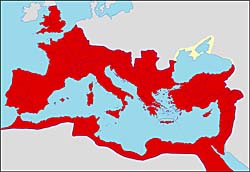
Unit 1: Redefining World Society and Culture
Lesson C: Rise and Fall of the Classical and Medieval World
Activity 1: Understanding the Concept and Foundation of Empires
Empires emerge when one country or group of people expand and take over other areas. In order to understand this process, view the presentation called The Rise of Empires and complete the questions found within.
Directions: When you are ready, select the Begin button to learn about The Rise of Empires.

Roman Empire at its Height [1]
Now that you understand how empires developed, let us look at one of the most famous empires in the world. The Roman Empire laid the foundation for the Western concept of empire and government. After the fall of the Roman Empire, every other western empire tried to duplicate its success. Many of the terms and concepts from the Roman Empire have been used throughout history. The Russians used the term czar (from Caesar) to refer to their kings. The United States uses the eagle as its symbol and some of the political structures that were created in Rome, such as the Senate and the concept of veto.
In 264 BCE, the Romans began to fight a series of wars to control the Mediterranean world. As time went on, generals who conquered new lands became more powerful. In 47 BCE, one of these generals, Julius Caesar, became the dictator of Rome. Julius Caesar was killed in 44 BCE. After a civil war, Julius Caesar's grandnephew, Augustus Caesar, became the first Emperor of Rome. This officially began the Roman Empire in 27 BCE. Other rulers, such Tiberius and Trajan, continued to expand the empire and bring peace and prosperity. In 117 CE, the Roman Empire included 3.5 million square miles of land and over 50 million people. The empire continued until the 5th century CE when internal and external pressures led to the fall of the Western Empire. The Eastern Roman Empire continued as the Byzantine Empire for almost another 1000 years.
Written Activity - Notebook
In your notebook, answer the following question:
- Many traditions and precedents emerged in the Roman Empire that will be seen in the other empires you will study. Take a moment to examine the following aspects of the Roman Empire. Record the traditions and precedents so that you can refer back to it as you examine other empires.
Page Notes:
[1] This image from http://commons.wikimedia.org/wiki/File:Roman_Empire_map.svg is licensed under the terms of the GNU Free Documentation License.

